The ADATA Ultimate SU800 SSD Review (128GB, 256GB, 512GB)
by Billy Tallis on February 1, 2017 12:01 PM ESTMixed Random Read/Write Performance
The mixed random I/O benchmark starts with a pure read test and gradually increases the proportion of writes, finishing with pure writes. The queue depth is 3 for the entire test and each subtest lasts for 3 minutes, for a total test duration of 18 minutes. As with the pure random write test, this test is restricted to a 16GB span of the drive, which is empty save for the 16GB test file.
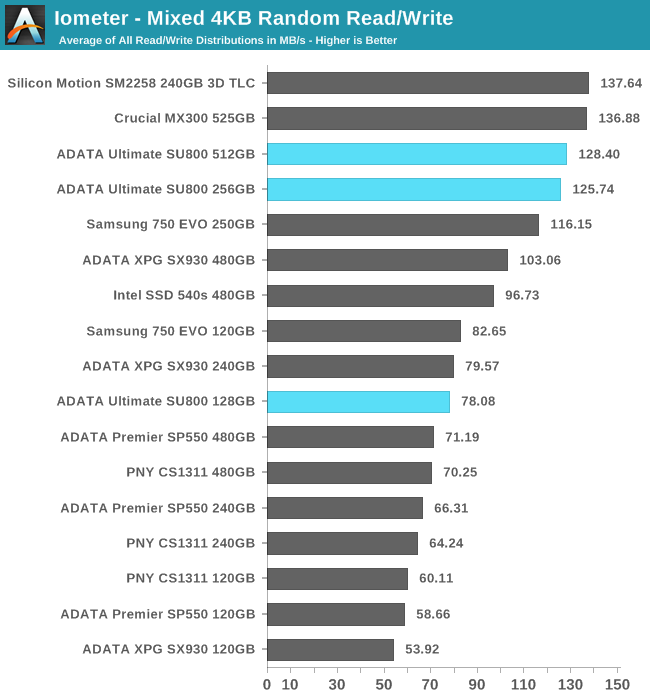
All three capacities of the ADATA SU800 deliver good performance for their class on this test. The Crucial MX300 and the earlier Silicon Motion engineering sample offer slightly higher performance.
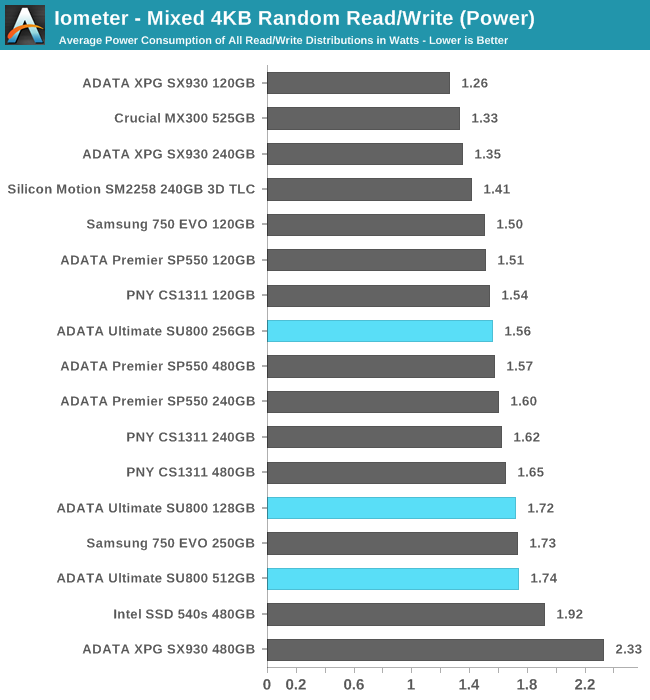
Power consumption is a little higher than average, but given the good performance, the SU800's efficiency is not bad.
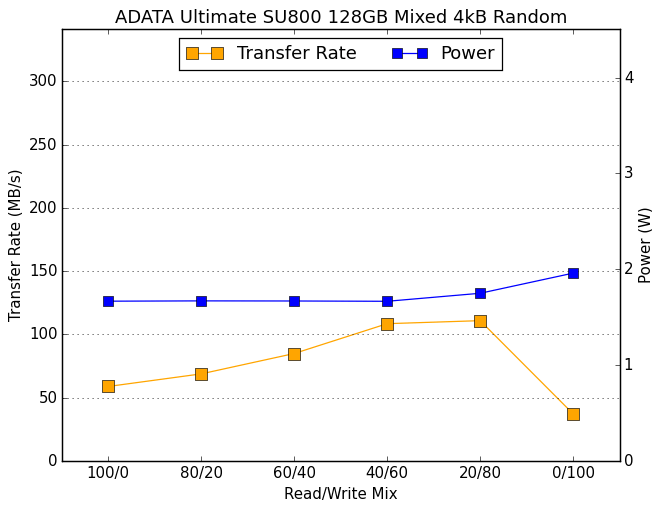 |
|||||||||
The 128GB SU800 runs out of SLC cache before the end of this test, leading to poor performance during the final phase of the test where the workload is 100% writes. The larger SU800s show increasing performance over the course of the test as more writes can be cached and combined.
Mixed Sequential Read/Write Performance
The mixed sequential access test covers the entire span of the drive and uses a queue depth of one. It starts with a pure read test and gradually increases the proportion of writes, finishing with pure writes. Each subtest lasts for 3 minutes, for a total test duration of 18 minutes. The drive is filled before the test starts.
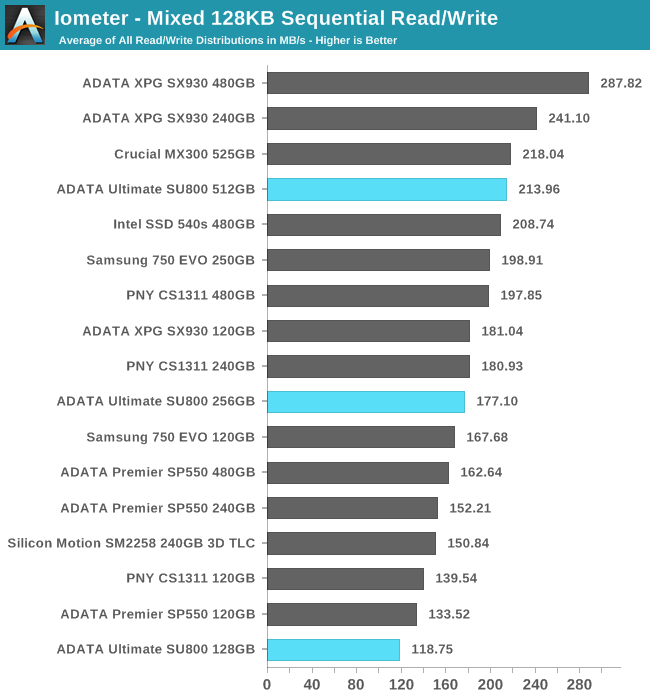
Capacity is a big factor in performance on this test. The 512GB SU800 performs quite well for a budget drive, while the 128GB is clearly slower than its competitors.
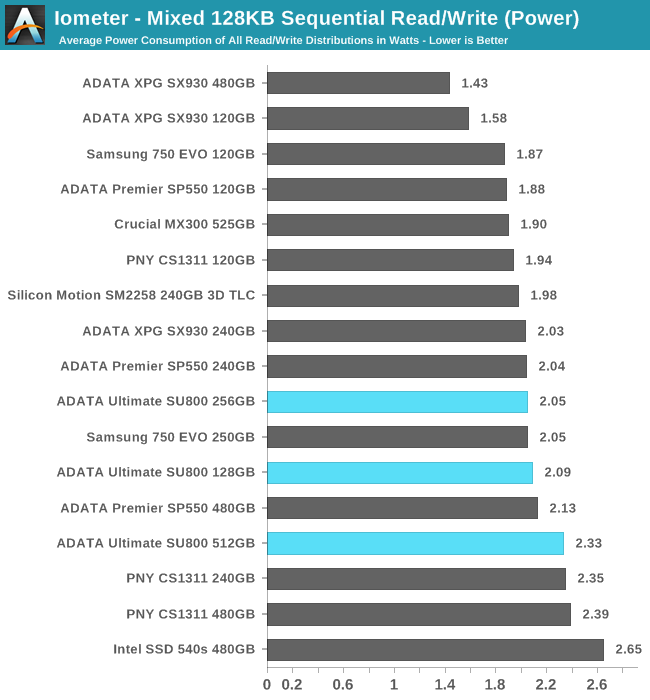
The power consumption of the SU800 on this test is only slightly higher than average.
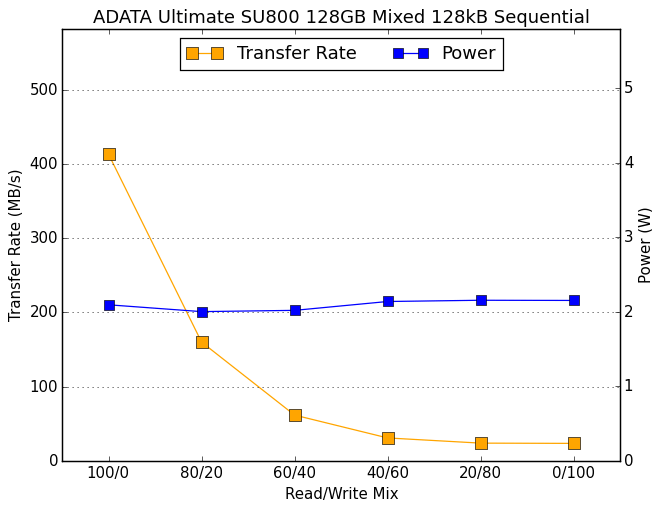 |
|||||||||
For the SU800, performance over the course of this test is largely a question of how soon the SLC cache fills up. The 128GB runs out very early while the 512GB doesn't bottom out until the second half of the test.










35 Comments
View All Comments
RamIt - Wednesday, February 1, 2017 - link
Why is there no comparison to the Intel 600p recently reviewed?extide - Thursday, February 2, 2017 - link
Probably because it is a PCIe drive. A shopper who is shopping for SATA drives is probably not interested in a PCIe drive.dj_aris - Thursday, February 2, 2017 - link
Sorry, but since all SATA 3 drives top at theoretical 600MBs but SSD speeds are WAY faster than that, what is the point in testing them?Death666Angel - Thursday, February 2, 2017 - link
It might just be my eyes, but I see a lot of instances where the drives don't actually achieve the 600MB/s data cap of the SATA3 protocol....dj_aris - Thursday, February 2, 2017 - link
Indeed, but who cares if it's 600 or 500 or even 300, when you can reach 2000+ using modern pcie storage (with similiar prices). SATA is dead, obviously will not be developed anymore, SATA express drives don't even exist. I mean we don't test DVD drives or floppies, right?doggface - Thursday, February 2, 2017 - link
Sata is dead? Seriously?Also, similar prices?
So many things wrong with this post.
Sata SSDs will continue to thrive for years to come. No doubt about that, and while they do, we will need reviews on their performance to help differentiate the good from bad. Especially as the industry continues to peddle TLC and even possibly QLC drives.
vladx - Thursday, February 2, 2017 - link
Upcoming QLC NAND is not something to scowl at. SSD drives using this technology will not be targeted to compete with MLC or even TLC instead they are planned for archival purposes: https://www.pcper.com/news/Storage/FMS-2015-Toshib...Billy Tallis - Thursday, February 2, 2017 - link
SATA isn't dead, but it is a dead end in the same sense that VGA ports are.extide - Thursday, February 2, 2017 - link
Not everyone's system is compatible with and/or cannot boot from NVME drives. There is definitely still a need to have these data points.lopri - Thursday, February 2, 2017 - link
Two of my boards refuse to accept any M.2 drive as a boot drive, leaving me no choice but to go with SATA. Plus SATA is nowhere near dead because it is still much more affordable. Plus there is no convincing argument as to why backups have to be saved in SSDs.